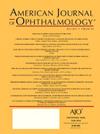Association of Age With Glaucoma and Visual Acuity Outcomes 10.5 Years After Unilateral Congenital Cataract Surgery
IF 4.1
1区 医学
Q1 OPHTHALMOLOGY
引用次数: 0
Abstract
OBJECTIVE
To determine the association among age, gestational age, glaucoma-related adverse events, and visual acuity following unilateral cataract surgery.
DESIGN
Post hoc follow-up of a multicenter randomized clinical trial.
METHODS
An analysis of 112 infants who had unilateral congenital cataract surgery between 1-6 months of chronological age. Data on long-term glaucoma-related status and visual acuity were collected when children were 10.5 years old. Intergroup comparison and correlation tests were performed, and associations of adjusted and chronological age with glaucoma and visual acuity at 10.5 years of age were assessed by logistic regression.
RESULTS
Chronological and adjusted age were highly correlated (Pearson correlation, r = 0.98, P < .001). Gestational age was not significantly associated with glaucoma (P = .08) nor visual acuity (P = .6). Younger adjusted age had a significant association with glaucoma (P = .04) and with better visual acuity (P = .03). Younger chronological age was not significantly associated with glaucoma (P = .06) but had a significant association with better visual acuity (P = .02).
CONCLUSIONS
Age adjusted for gestation and chronological age are important risk factors for glaucoma and visual acuity in patients who have undergone cataract removal in infancy. Among the IATS participants, age adjusted for gestation significantly predicted glaucoma-related adverse events at 10.5 years. Conversely, chronological age was significantly associated with visual acuity at 10.5 years. Adjusted age should be considered in addition to chronological age when determining age of cataract surgery to minimize the risk of glaucoma and maximize visual acuity.
求助全文
约1分钟内获得全文
求助全文
来源期刊
CiteScore
9.20
自引率
7.10%
发文量
406
审稿时长
36 days
期刊介绍:
The American Journal of Ophthalmology is a peer-reviewed, scientific publication that welcomes the submission of original, previously unpublished manuscripts directed to ophthalmologists and visual science specialists describing clinical investigations, clinical observations, and clinically relevant laboratory investigations. Published monthly since 1884, the full text of the American Journal of Ophthalmology and supplementary material are also presented online at www.AJO.com and on ScienceDirect.
The American Journal of Ophthalmology publishes Full-Length Articles, Perspectives, Editorials, Correspondences, Books Reports and Announcements. Brief Reports and Case Reports are no longer published. We recommend submitting Brief Reports and Case Reports to our companion publication, the American Journal of Ophthalmology Case Reports.
Manuscripts are accepted with the understanding that they have not been and will not be published elsewhere substantially in any format, and that there are no ethical problems with the content or data collection. Authors may be requested to produce the data upon which the manuscript is based and to answer expeditiously any questions about the manuscript or its authors.

 求助内容:
求助内容: 应助结果提醒方式:
应助结果提醒方式:


